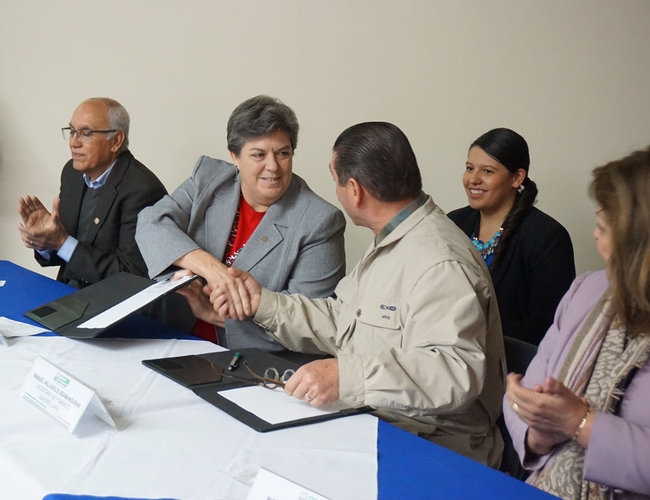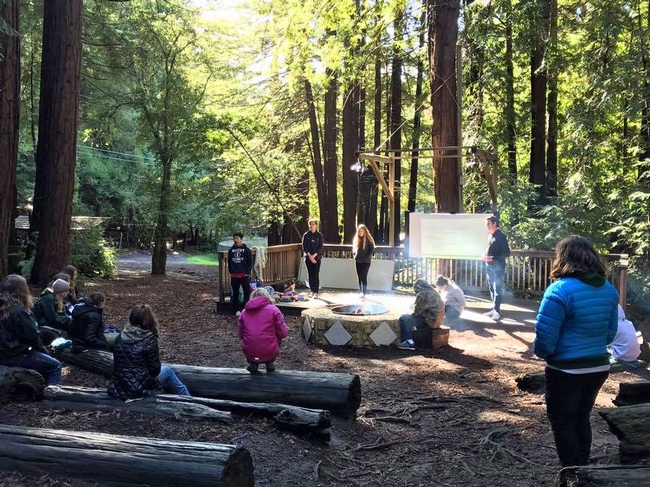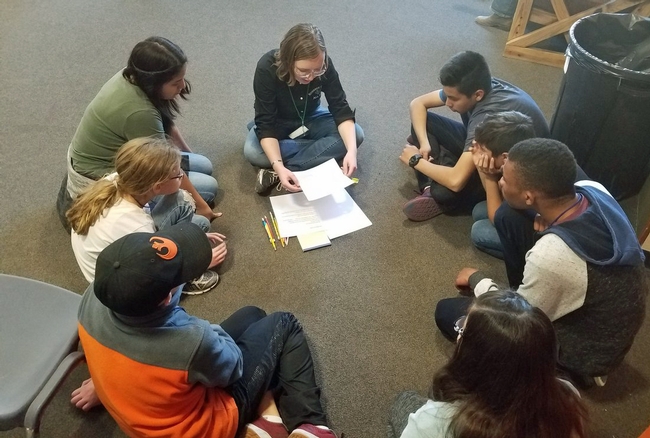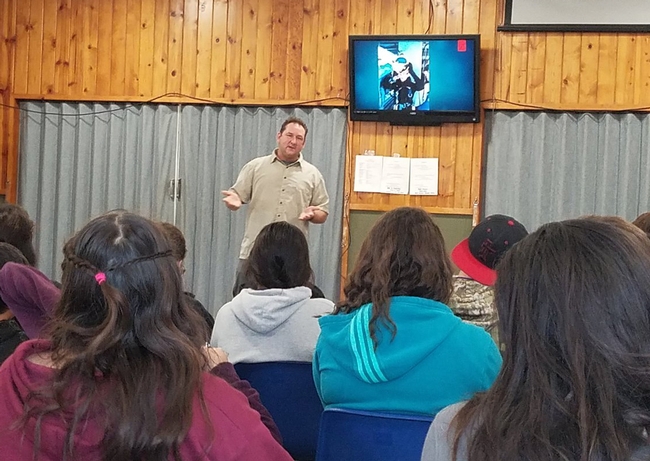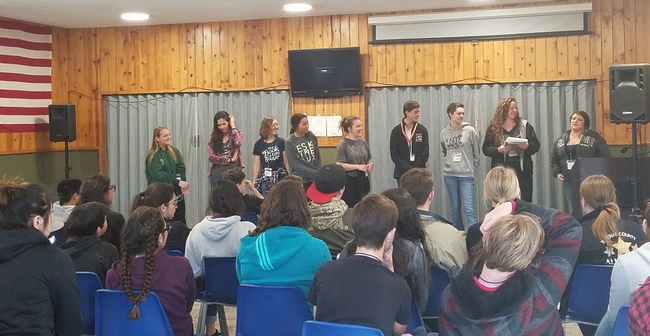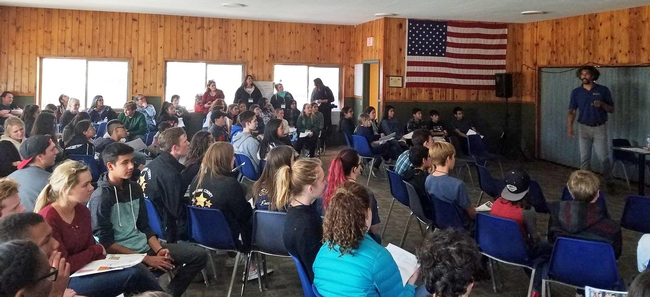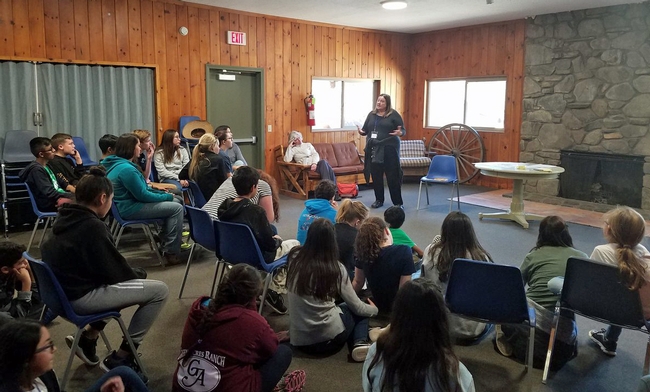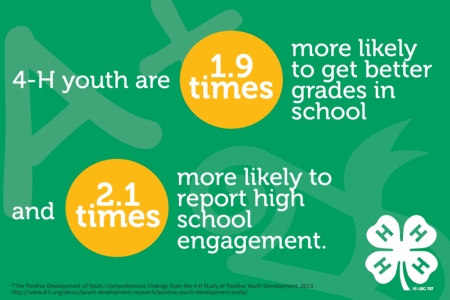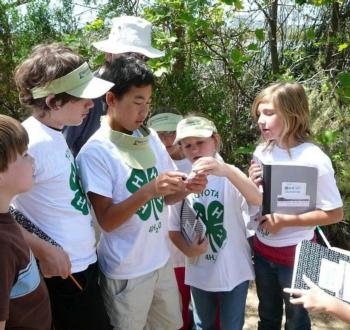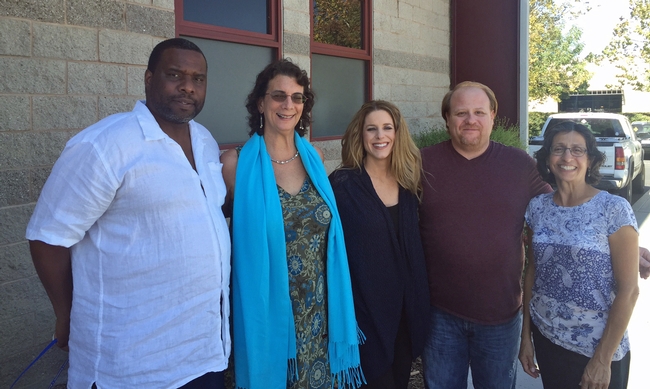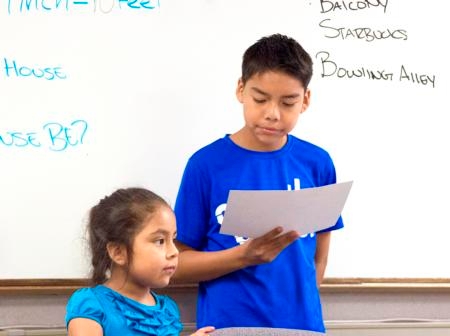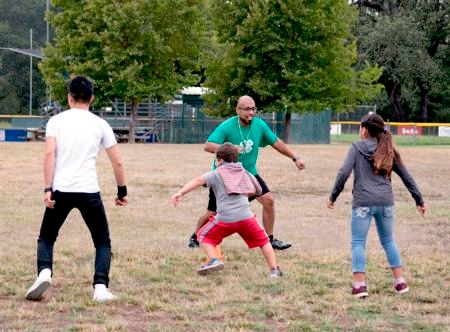Posts Tagged: Lupita Fabregas
California state senator to honor University of California 4-H program in Mexicali
California State Senator Ben Hueso will honor California and Baja California 4-H with a resolution in the State Senate at 2 p.m. April 2 to recognize the cross-border team that established a 4-H Club in Mexicali, Baja Mexico, in January 2017.
Last year, UC ANR Vice President Glenda Humiston signed a memorandum of understanding with the Baja California Secretary of Agriculture Development, Manuel Vallodolid Seamanduras, to offer UC's 4-H expertise to youth south of the border. The agreement increases the academic, scientific, technological and cultural cooperation that are part of UC President Janet Napolitano's Mexico Initiative.
Senator Hueso's resolution attests to the value of building relationships as a means of cooperative engagement between Mexico and California on shared concerns, such as drought and global climate change. The resolution notes that the creation of a 4-H Club in Mexicali is an inspiring reminder that the need for education doesn't stop at the border.
Senator Hueso represents the 40th District, which includes parts of San Diego County and all of Imperial County, running along the entire border between California and Mexico.
|
What: |
Resolution honoring the establishment of a 4-H Club in Mexicali, Baja Mexico. |
|
Where: |
California State Senate |
|
When: |
2 p.m., Monday, April 2, 2018 |
|
Who: |
Manuel Vallodolid Seamaduras, Secretary of Agriculture Development in the State of Baja California, Mexico (Secretaría de Desarrollo Agropecuario del Estado de México - SEDAGRO) Carlos Orozco Riesgo Belem Avendaño Ruiz Guillermo Gonzalez Rubio Agustin Manuel Velazquez Bustamante Mark Bell, Ph.D., Vice provost, UC Agriculture and Natural Resources Shannon Horrillo, Ph.D., 4-H Youth Development statewide director Lupita Fabregas, Ph.D., 4-H Youth Development assistant director for diversity and expansion Claudia Diaz Carrasco, 4-H Youth Development advisor, Riverside & San Bernardino, Calif. |
|
Contact: |
(English) Jeannette Warnert, UC ANR Strategic Communications, (559) 240-9850, jewarnert@ucanr.edu
|
Latino youths increase their presence in UC ANR 4-H program
For more than 200 youngsters in California, including 45 Latinos, the last weekend of January was a unique experience, full of physical activities and workshops that will help them build a successful future. Under the theme “Be a leader, Be a hero,” they participated in the 4-H Youth Summit carried out in several California counties. The event showcased the efforts of UC Agriculture and Natural Resources to increase the participation of young Latinos in its 4-H Youth Development Program.
“We are very excited that for the first time 45 Latino youths participated in the Youth Summit,” said Lupita Fabregas, 4-H assistant director for diversity and expansion.
The participating youths, ages 11 to 19, enjoyed hiking and other outdoor activities at the various 4-H camps. Among the camps were Mountain Center, located in the San Jacinto Mountains in Riverside County; YMCA Camp Jones Gulch in La Honda, located in the Santa Cruz mountains in San Mateo County; and Wonder Valley Ranch in Sanger, located in Sierra Nevada Mountains in Fresno County.
The adolescents had the opportunity to learn skills to help them develop their potential in addition to other topics of interest.
“Participants also had the opportunity to learn about engineering design process and the importance of bees to the environment,” said Claudia Diaz-Carrasco, 4-H advisor in San Bernardino and Riverside counties.
The increase of Latino youth in these 4-H camps, is the result of an initiative that has been implemented within the last couple of years.
Seven California counties including Kern, Riverside, Merced, Monterey, Orange, Santa Barbara and Sonoma were selected to participate in a pilot model to increase the number of young Latinos participating in the 4-H program.
The model was designed to ensure that young people living in urban areas could receive the same benefits as those who have participated in 4-H since it was founded in 1902 in Ohio.
“The original goal was that young men and women learned leadership skills through interaction with farm animals and food conservation,” added Fabregas.
For the 21st century, 4-H has designed new methods for young people in rural communities, urban and suburban areas based on the same original principles – offering leadership skills to its participants.
"The 4-H participants learn about issues of global importance such as food security, climate change and sustainable energy. It also teaches them about other issues, such as childhood obesity, and basic finance," said Diaz-Carrasco, who has seen a considerable increase of Latino participants in the 4-H programs in the Inland Empire.
“It was hard, we had many challenges,” said Diaz-Carrasco, who works in a county that is 50 percent urban and its young population is almost 59 percent Latino. Lack of transportation, time and money were the biggest threats to the success of the pilot model.
In 2016, Diaz-Carrasco was selected to participate in UC ANR's Latino initiative, under the direction of Lupita Fabregas. The first step taken was to hire the first bilingual educator of the 4-H program and establish the first bilingual club in a community center in a heavily Latino populated part of the city of Riverside.
"These new models have had an impact on the program in the seven pilot counties," said Fabregas. Two years later, there are three bilingual clubs in the county.
The response from the Latino youth has exceeded expectations. In 2015, the California 4-H program worked with less than 1 percent of children in the state. By 2017, participation in the program grew 16 percent and the participation of Latino children increased 89 percent.
Parents of these young Latinos participating in the 4-H program are seeing positive changes in their kids. According to the parents, 4-H gives their kids an opportunity for social and personal interaction. “It enables young people to understand who they are and prepares them to choose what they are going to do with their life as adults,” said Sergio Sierra, whose children are participating in the 4-H program in Indio, California.
Studies have shown that young people participating in the 4-H program are 1.9 times more likely to get better grades in school and 2.1 times more likely to report being engaged in school activities.
California leads the country with more participants in the 4-H Latino Initiative than other states. In spite of the gains achieved, there is still more outreach to be done, Fabregas said.
Mexican children get UC help to find and focus their passions
The same day, an opening ceremony launches a journey of exploration into the world of food production and healthy eating for a group of 8- and 9-year-old Mexican children.
The UC Cooperative Extension 4-H Youth Development Program sponsors clubs that combine hands-on learning and positive youth-adult partnerships to help children develop skills they need to succeed in life.
“Children in Mexico also need to find and focus their passions, they need life skills and support in order to become responsible citizens and give back to the community,” said Lupita Fabregas, 4-H Youth Development advisor and assistant director for 4-H diversity and expansion. “We have decades of experience and extensive programming to offer. It is a natural partnership.”
Humiston was a member of 4-H herself as a youth and credits the program for setting in motion a successful career that includes serving as a Peace Corps volunteer, earning a doctorate degree at UC Berkeley, playing a role in the Bill Clinton and Barack Obama presidential administrations, and later taking the helm at UC Agriculture and Natural Resources.
“I encourage all children to find a place like 4-H to work with mentors, get hands-on experience, and learn about their own potential,” Humiston said. “This historic agreement will allow children in Mexico to benefit from a 100-year-old program that has had tremendous success in the United States and it will build academic, scientific, technological and cultural relations between Mexico and California for the advancement of children.”
The new club in the Mexicali community of Sinaloa will have access to two greenhouses that belong to the Secretary of Agricultural Development in Baja, Mexico, where they will grow cucumbers and tomatoes while they learn about soil science, irrigation, nutrition education and other components of agricultural science.
The children will also learn leadership skills by taking a new role in their communities, running in club elections, speaking in public and reporting on their work. The children's parents will also be encouraged to serve as volunteer leaders, mentors and educators.
|
What: |
University of California Agriculture and Natural Resources and the Secretary of Agricultural Development in Baja, Mexico, sign a memorandum of understanding. Opening ceremony for the first club modeled after the successful California 4-H Youth Development Program in Ejido Sinaloa, Baja Mexico. |
|
When: |
Friday, Jan. 20 9:30 to 9:50 a.m. – Memorandum of understanding signing 9:50 to 11:50 a.m. – Children take part in their first session of 4-H programming, learning “Where does our food come from?” |
|
Where: |
Secretaria de Fomento Agropuecuario |
|
Who: |
Glenda Humiston, vice president of UC Agriculture and Natural Resources Manuel Valladolid Seamanduras, secretary of the Mexican agricultural development program (La Secretaria de Fomento Agropecuario de Baja, México) Parents, students, teachers, principal, University of Baja California personnel, 4-H volunteers, UC Cooperative Extension 4-H Youth Development staff and academics |
|
Visuals: |
Children participating in a 4-H Club project that involves healthy eating and agricultural production. |
|
Contact: |
Jeannette Warnert, (559) 240-9850 (call or text), jewarnert@ucanr.edu |
View this media advisory in Spanish.
4-H Youth Development team wins national diversity award
UC 4-H Youth Development advisors Dorina Espinoza, Russell Hill, Fe Moncloa and Keith Nathaniel and 4-H associate director Shannon Horrillo have won the National Extension Diversity Award for systematically enhancing the intercultural competency of 4-H personnel and others in California. The National Extension Diversity Award was presented Sunday, Nov. 13, at the 129th Association of Public and Land-grant Universities Annual Meeting in Austin, Texas.
The award, given by USDA National Institute of Food and Agriculture (NIFA), Cooperative Extension System and the APLU, honors the team for developing and institutionalizing a professional development strategy to increase staff and academics' intercultural competence.
To support the development and well-being of California's culturally and ethnically diverse youth population, research indicates that building intercultural competence among youth development professionals is critical.
“We have been making changes to our programs to remove barriers and make 4-H more accessible. We are also testing new delivery models to expand 4-H's reach, particularly among Latino youth and families,” Horrillo said.
“This effort has been extremely successful and we are seeing the benefits in our membership,” said Horrillo. “The program's growth over the last year was significant, with a 16 percent increase in youth participation and a nearly 42 percent increase in Latino youth participation.”
“We asked Latino parents how we can help,” said Lupita Fabregas, assistant director for 4-H Diversity and Expansion. “Working parents suggested after school programs so they don't have to drive their kids to a different location.”
Through a pilot initiative in seven counties – Riverside, Orange, Kern, Santa Barbara, Monterey, Merced and Sonoma counties – UC ANR's 4-H Youth Development Program now offers in-school, after school and special interest clubs that explore subjects such as robotics. Children can join clubs that focus on projects for four to six weeks, rather than 4-H's year-long commitment. Bilingual and bicultural program representatives provide materials in English for the children and Spanish for parents. Although the activities are structured differently, they aim to teach Latino children science, leadership, civic engagement and other life skills taught through the traditional program.
The team of change agents applied the professional development strategy over three years, providing 176 hours of intercultural communication feedback sessions, learning communities and regional conferences to enhance the intercultural competence of 65 California 4-H personnel.
The UC ANR 4-H Youth Development Program has also assembled an advisory committee for 4-H multicultural and community engagement that includes Latino leaders Mary Lou de Leon Siantz, a professor at the Betty Irene Moore School of Nursing at UC Davis and director of the Center for Advancing Multicultural Perspectives on Science (CAMPOS); Steven Olmos, chief schools officer for Santa Clara County Office of Education; Albert Maldonado Jr., youth program manager for The California Endowment; and Juan P. Garcia, deputy director of the California Hispanic Chambers of Commerce.
UC ANR's action plan and resulting positive change provides a model for 4-H in other states to improve professional development and expand the program's reach. A summary of California's IDI professional development activities can be found in the National 4-H Latino Youth Outreach: Best Practices Toolkit, Professional Development.

